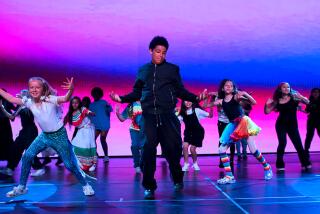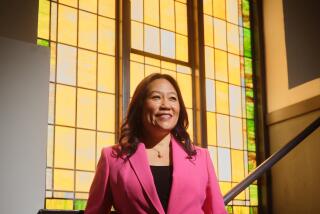Arts Education Grows With Performing Tree : Nonprofit Group Helps Teachers Teach and Students Learn by Exposure and Involvement
The children at 3rd Street School bobbed and wiggled in their seats as they listened to live jazz. Students at Pacoima Junior High moved rhythmically to conga drum beats in a dance workshop, and youngsters at Rio Vista Elementary sat transfixed by an opera performed on the small stage of their school auditorium.
At a dinner party, professional artists discussed how to work in educational settings, and in a high school gym, teachers watched a video and learned, by dancing, how to use movement to help teach their students about myths, legends and language.
Branches of One Group
All those events, and many more like them, took place in a recent week, and all were branches of the same tree: the Performing Tree.
Based on the premise that a childâs education isnât complete without direct exposure to the arts, Performing Tree is a nonprofit arts-in-education agency that unites educators, professional artists and children, and functions as a service to all three.
Because those who run the local organization believe art should be more than a spectator sport, Performing Tree offers performances, student workshops, teacher training, videos and publications, and consultation. For 12 years, the organization has brought actors, singers, dancers, musicians, puppeteers, and literary and visual artists to schools throughout Los Angeles County.
âI believe the arts give a child an opportunity to experience all types of feelings, good and bad, and to grow in visual perception and literacy,â said Beth L. Cornell, Performing Treeâs executive director. âThere will be those children that buy into football, but there will be those that buy into the arts. And if a child buys into the arts, it will keep him in school.â
Founded in 1973
Performing Tree was founded in 1973 as a three-year pilot program of the Junior League of Los Angeles under the co-sponsorship of the Music Centerâs Performing Arts Council.
Incorporated as a private nonprofit organization in 1976, it operates on a budget of about $550,000, with about half the money from school fees and the rest from corporate and private donations.
The groupâs roster of artists totals 260. Among them, Patricia Bulitt teaches about Alaskan Eskimo culture and dance, Jon Pearson presents âCreative Thinking Through Cartooning,â and twins Janet and Judy Robinson perform a âMusical Tour of the 50 States.â
Performing Tree also provides artists-in-residence for schools, has programs for handicapped and gifted students, and provides a multicultural mix of performers, some of them bilingual.
In collaboration with ex-ballet star Jacques dâAmboise and his National Dance Institute, the Mark Taper Forum, and the Los Angeles Unified School District, Performing Tree helped stage a theatrical production here in June with 120 singing and dancing students from four elementary schools.
At the 3rd Street School recently, the Billy Mitchell jazz group gave a lecture-performance arranged by Performing Tree. Mitchell and his three-piece band delivered a loud and rousing âOverview of Jazz,â explaining historical trends and playing tunes from ragtime to fusion. The elementary school students giggled gleefully when band leader Mitchell blurted out âBe-Bop!â or âBoogie-Woogie!â and wrote the words on a black board.
âArt develops the soul,â said Mitchell, who has worked with Performing Tree for about two years. âMath and science are good, but they donât give you the sensitivity that will develop the human dynamic that allows you to respond and relate to other people.â
âPart of Lifeâ
âI really liked the music and learning about the instruments,â sixth-grader Alexander Merlis said, âmusic is an art form, and art is part of life.â
At the Magnet Center for Television, Theater and Fine Arts at Pacoima Junior High School, Michael Bell, a member of the Free Flight Improvisational Dance Company, recently led a three-day, three-hour Performing Tree workshop for advanced dance students. An energetic Bell supervised an original group choreography.
Children today âdonât know the value of dance as an art form,â Bell said. âWe teach lines, levels, shapes, timing and other movement qualities, to make them aware of space, and to look at dance as an art.â
Performing Tree employs about 60 âArtist Specialistsâ such as Bell to conduct workshops, which range from three to 17 sessions long. The groupâs printed materials and videos help teachers integrate both performance and workshop experiences into their academic curriculum. âItâs important to leave resources for the teachers to use once the artists have left the classroom,â Cornell said.
School districts throughout the country use Performing Tree publications. The workbooks serve a function similar to a recently produced Performing Tree video series titled âExploring Curriculum Ideas Through Dance.â The videos, for elementary school teachers and students, show how dance can be used to teach about marine life, health and safety, and myths and legends. Related teacher workshops show instructors how to enrich their classroom curricula with knowledge gained from the videos.
Cornell, who headed the arts and education segment of the Pennsylvania Council on Arts for three years before joining Performing Tree in 1982, explained that smoothing the way for artists to enter educational arenas is an important aim of her agency.
âProfessional artists have to be prepared to understand the educational system,â she said, âartists must learn to adapt to rigid school schedules, and educators have to be responsive to the needs of the artistsâ by providing dressing rooms or perhaps a well-tuned piano.
Performing Tree offers a two-day course to acclimate artists to schools, seminars in professional development, and a mentorship program in which artists who have already worked in the system advise those new to it.
Handbook of Tips
A âdoâs and donâtsâ handbook is available for artists working in schools and community institutions, as are consultations to guide artists and teachers on grant application and grant proposal writing and on designing arts programs for schools. The organization also offers aesthetic guidance to artists, evaluating new works with a gentle hand.
âPerforming Tree has helped me loads with my career,â dancer Bell said. Also a composer of music for dance, he said the combined support of the Free Flight Improvisational Dance Company and Performing Tree has allowed him to experiment with new ventures. âThey have let me take my fantasies and dreams and turn them into realities. If something isnât perfect, they help me with it.â
In the last eight years, Performing Treeâs services have expanded 600%. Since its inception, it has more than quadrupled the number of schools it serves and about doubled its roster of performing groups. âThis year so far, we are in 183 schools,â Cornell said. âWhat makes us unique is the ability to address the particular needs of a school site.â
Monte Vista Elementary School in West Covina is in the fourth year of a five-year sequential program with Performing Tree.
âWhat has made this program so successful is the professionalism, interest and support we get from Performing Tree,â said Kim Preston, Monte Vistaâs principal. âAll the artist specialists we have used have a keen insight into how children learn and how teachers teach. Children need a total opportunity to develop all their skills and awarenesses and this program gives a quality and depth to their education.â
More to Read
Sign up for Essential California
The most important California stories and recommendations in your inbox every morning.
You may occasionally receive promotional content from the Los Angeles Times.










